
DMT-Nexus member

Posts: 14191 Joined: 19-Feb-2008 Last visit: 22-Nov-2025 Location: Jungle
|
From Ayahuasca Admixtures WorkspaceTabernaemontana sananho Ruiz & Pav. 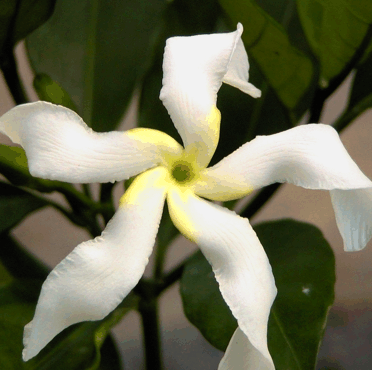 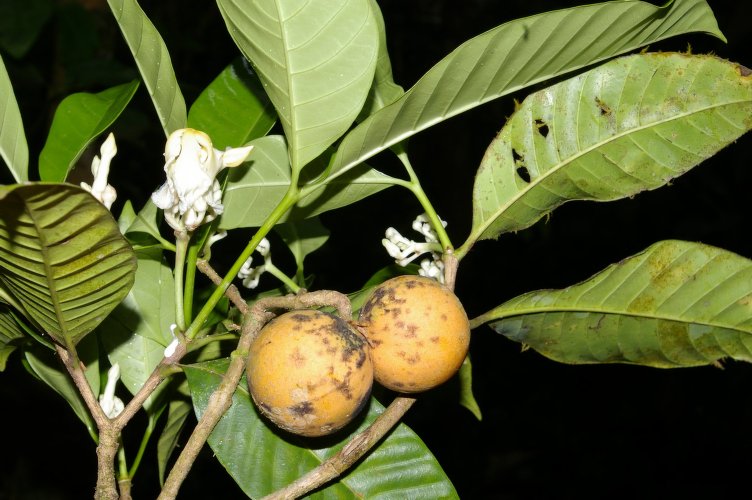 Synonyms Synonyms ( Tropicos.org) : Bonafousia sananho (Ruiz & Pav.) Markgr ; Merizadenia sananho (Ruiz & Pav.) Miers ; Taberna poeppigii (Müll. Arg.) Miers ; Tabernaemontana poeppigii Müll. Arg. Herbarium Botanical Voucher: Link
Distribution (discoverlife.org): 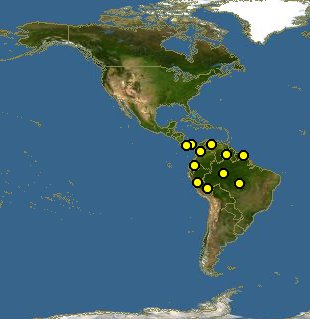 Ethnomedicinal use Ethnomedicinal useApparently added to ayahuasca (bark? root? Citation needed) It is used as eyedrops by the Kaxinawa, using the juice (acqueous extraction? Squeezed 'resin'?) of the root and trunk scrapes, for the purpose of improving luck and concentration when hunting. Also when being stung by "tocandira" and stingray, topically applied. Also the latex from the bark is used for tooth ache, topically applied with some cloth, until the tooth falls out. (Ika Muru, 2014) Much as T. rimulosa. The leaves, softened by fire, are applied to relieve rheumatic pains. In Pastaza, taken one week after delivery. "Pulp is used as a gargle for sore throat and colds". "Tikuna" mix the latex with water for eye wounds . "Jivaro" apply the bark juice to toothache. Considered sudorific, tonic, used for colds, obesity, rheumatism, syphilis. ( Amazonian Ethnobotanical Dictionary) Colombia: A mixture of latex and water can be used to cure eye wounds [375]. (Van Beek et al 1984) Peru: In the upper part of the Amazon the plant has long been considereda panacea, the name sanango signifies a more or less all-purpose medicinal plant. In the Leticia area it is employed as a febrifuge, emetic, diuretic, calmative and for various minor ailments. A tepid decoction of the leaves and bark is used to wash wounds and afterwards powdered bark is put over the wound; this is repeated three times a day for 10 days. A water extract of the root is drunk three times a day during 15 days against rheumatism and for wounds [ 375]. (Van Beek et al 1984) Peru, Brazil: An infusion of the roots is used against rheumatic pains [376]. (Van Beek et al 1984) Alkaloid content: 1% alkaloids (sample from Satipo) - 7.5% alkaloids (sample from Tarapoto) of which Coronaridine 30-38% , Heyneanine 18-20% , 10% 19-Hydroxycoronaridine, 0-2% Ibogamine and 2-3% Voacangine ( G. delle Monache et al 1977) 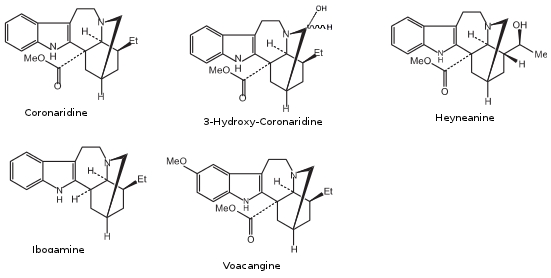 Alkaloid info and pharmacology Alkaloid info and pharmacology (Van Beek et al 1984) Coronoaridine CAS: 467-77-6 338.44 g/mol The alkaloid has been tested in the mouse, cat, dog, monkey and rat by a variety of pharmacological procedures. It showed autonomic and CNS activity. In mice it produced analgesia and was effective in suppressing rage caused by foot-shock. Toxicity in the anesthetised cat appeared to be associated with respiratory depression. Coronaridine was inactive in the 9 KB system in cell culture [ 150]. In a general pharmacological screening, the compound exhibited little activity [164]. A single 30 mg/kg p.o. dose of coronaridine prevented pregnancy in rats when given on day 1, 2, 3 or 4 after coitus. When given on day 5, 6, 7 or 8 of pregnancy, the results were only partially successful. The substance showed estrogenic activity, and it was this activity which appeared to be responsible for the antifertility action. However, the alkaloid was devoid of anti-estrogenic, androgenic, anti-androgenic, progestational, anti-progestational and uterine-stimulant 3-hydroxy-CoronaridineCAS: 56867-69-7 354.19 g/mol The substance had strong antibiotic activity [ 382] IbogamineCAS: 481-87-8 280.41 g/mol Central-stimulating properties were observed in a general pharmacological screening, and in mice, when administered S.C. together with Rididyl i.p., the alkaloid produced jactatio capitis [164]. On iv. injection into anesthetised guinea pigs, the effects observed were the same as with ibogaine (q.v.) [221]. Ibogamine was not active in the P-388 or KB test systems in cell culture [ 353] VoacangineCAS: 510-22-5 368.21 g/mol In a general pharmacological screening, voacangine exhibited a slight central stimulating effect. The LDSo i.v. in the mouse was 54 mg/kg [ 164]. When injected i.v. into anesthetised guinea pigs it produced the same effects as did ibogaine (q.v.) [221]. Voacangine had no effect on the heart [ 178]. The alkaloid was not active in the P-388 and KB test systems in cell culture [353]. Analysis DataGC-MS data (still lacking info on 3-Hydroxy-Coronaridine) : Mass Spectrometry Data table (Zocoler et al 2005) TLC system: toluene-ethanol-ammonia (95:5:5, v/v/v ). Reagents used for TLC visualization: Dragendorff's reagent, iodoplatinate, ferric chloride-perchloric acid (FCPA), and ceric sulphate-sulfuric acid (CSSA) (Zocoler et al 2005) Plant vendors:USA: Plant CuttingEurope: Wood (bark?) DMT Nexus related threads: Tabernaemontana sananho ; Ayahuasca Admixtures WorkspaceTabernaemontana undulata Vahl 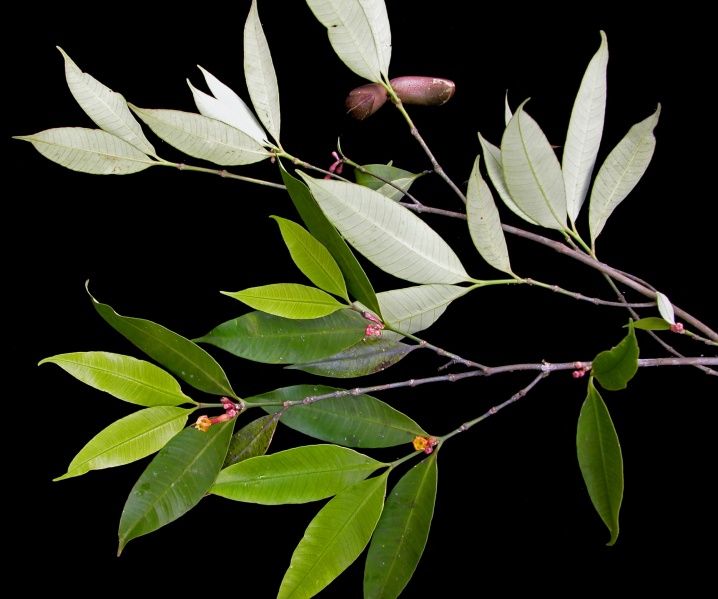 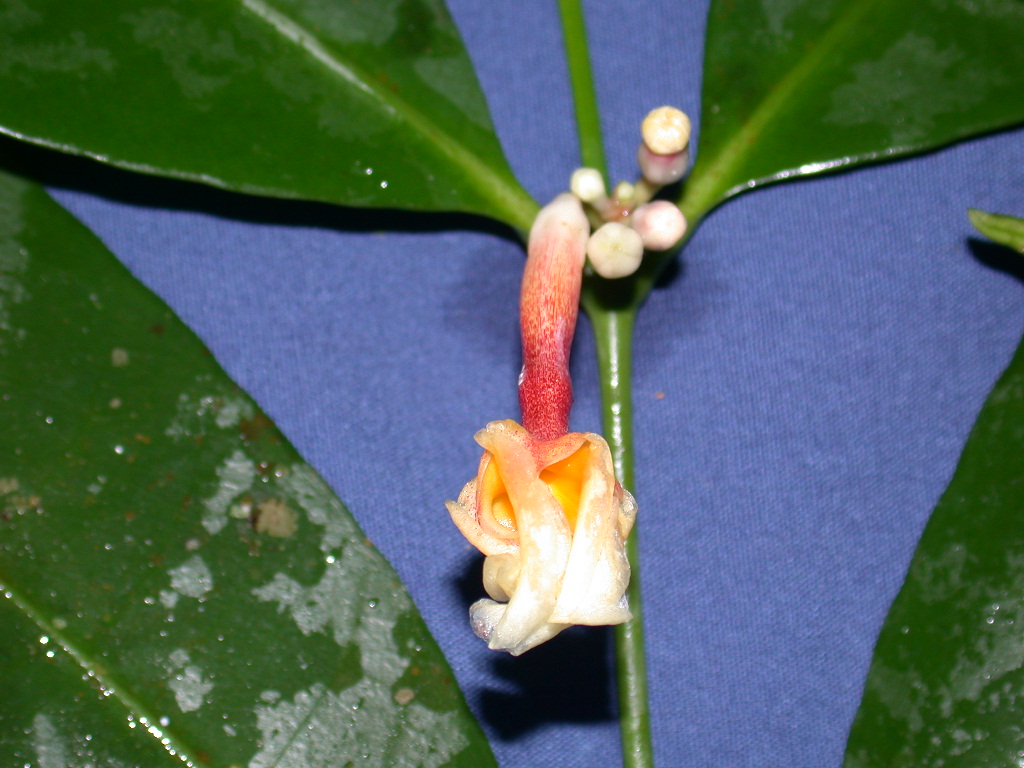 Synonyms ( tropicos.org): Anacampta albescens (Rusby) Mrkgr; Anartia meyeri (G. Don) Miers; Bonafousia obliqua Miers; Bonafousia perrottetii (A. DC.) Miers; Bonafousia undulata (Vahl) A. DC. ; Bonafousia undulata var. ovalifolia Miers; Echites brasiliensis Thunb. ; Peschiera surinamensis Miq. ; Stemmadenia nervosa Standl. & L.O. Williams; Tabernaemontana albescens Rusby ; Tabernaemontana meyeri G. Don ; Tabernaemontana meyeri G. Don ; Tabernaemontana perrottetii A. DC.(tropicos.org) Herbarium Botanical Voucher: Smithsonian Tropical Research Institute ; FMNHDistribution: Brasil, Colombia, Costa Rica, Ecuador, Guyana, Guyana Francesa, Panamá, Perú, Surinam, Trinidad y Tobago, Venezuela ( STRI) Ethnomedicinal useCalled Becchete (pronounced B'-chew-teh by the Mati and Matses tribe, applied to the eye to improve eyesight also for better hunting. (Lambert et al 2010)  Alkaloid content: Alkaloid content: Quebrachidine, Voaphylline, Coronaridine, (-)-19-epi-Heyneanine, Voacangine, Unknown base (M+ 382) (Van Beek et al, 1984) Eglandine, voacangine, Isovoacangine, Conopharyngine, Jollyanine, (-)-19-epi-Heyneanine, Heyneanine / 20-hydroxycoronaridine, Coronaridine, Ibophyllidine, hydroxy-7-indolenine, 11-hydroxy-coronaridine, 10-hydroxy-heyneanine, 11-hydroxy-heyneanine, dimer alkaloid mass 706 ( Ladhar et al 1981) coronaridine, voacangine, 19R-heyneanine, 19R-voacristine, 18-hydroxy-coronaridine, 18-hydroxy-voacangine Van Beek et al 1985DMT-Nexus related thread Becchete visionary eyedropsVendors: Seeds - potential vendor 1 (not checked yet) ReferencesCardoso et al 1997. Gas chromatographic analysis of indole alkaloids from Tabernaemontana hilariana. Journal of Chromatography A, 788 (1997) 204-206 Ika Muru, Agostinho Manduca Mateus (2014). Una Isi Kayawa: Livro da cura do povo Huni Kuin do Rio Jordao. Dantes Ed., Rio de Janeiro, 2014 Lambert M Surhone, Mariam T Tennoe, Susan F Henssonow 2010 Tabernaemontana undulata ( Link). Verlag Dr. Mueller AG & Co. Van Beek et al, 1984. Tabernaemontana L. (Apocynaceae): A review of its taxonomy, phytochemistry, ethnobotany and pharmacology. Download linkZocoler et al 2005. Qualitative determination of indole alkaloids of Tabernaemontana fuchsiaefolia (Apocynaceae). J. Braz. Chem. Soc. vol.16 no.6b São Paulo Nov./Dec. 2005. Download linkG. delle Monache, S.M. de Matta, F. delle Monache and G.B. Marini-Bettolo (1977) Sugli alcaloidi di Tabernaemontana sananho R. & P. Atti Accademia Nazionale dei Lincei, Memorie, Classe di Scienze Fisiche, Matematiche et Natumli [viii] 62, 221.
|
|
|
|
|

DMT-Nexus member
    
Posts: 1367 Joined: 19-Feb-2008 Last visit: 12-Jun-2016 Location: Pacific Northwest
|
SourceAuthor(s): Kevin A Jernigan Year Published: 2009 Title: Barking up the same tree: a comparison of ethnomedicine and canine ethnoveterinary medicine among the Aguaruna Pages: n/a Journal: Journal of Ethnobiology and Ethnomedicine, 5:33 Link/URL: http://www.ncbi.nlm.nih....0/pdf/1746-4269-5-33.pdfInformationT. sananho known locally as "kunakip" among the Aguaruna. Said to be "waimatai" (vision-producing). Bark and roots are administered to dogs to improve hunting ability; route of administration (ROA): "inhaled in mouth, nose, fed". Used similarly by humans, but with different ROA (human ROA not specified). The bark is fed to dogs to treat lack of appetite (a use not seen in humans). The sap is applied topically to treat dermatitis in dogs and humans. ----
|
|
|

DMT-Nexus member
    
Posts: 1367 Joined: 19-Feb-2008 Last visit: 12-Jun-2016 Location: Pacific Northwest
|
[The following are all in reference to Tabernaemontana sananho] A few additional notes on Van Beek et al. 1984 (referenced in the first post of this thread): The passages on ethnomedicinal uses cite other sources ([375] and [376]). Here are full citations for those sources: - [375]: R.E. Schultes (1979) Journal of Ethnopharmacology 1, 165.
- [376]: Simposio internazionale sulla medicina indigena e popolare dell’America latina, Dec. 1977, Istituto Halo-Latino-Americano, Rome, 1979, p. 100.
All the alkaloids listed (coronaridine, 3-hydroxycoronaridine, (-)-heyneanine, (-)-ibogamine, and voacangine) were isolated from the bark. Van Beek et al. cite the following reference as the source of this information: - [338]: G. delle Monache, S.M. de Matta, F. delle Monache and G.B. Marini-Bettolo (1977) Atti Accademia Nazionale dei Lincei, Memorie, Classe di Science Fisiche, Matematiche et Natumli [viii] 62, 221.
Now for some new sources:
Source: Ott, J. 2001. Shamanic Snuffs or Entheogenic Errhines. Entheobotanica: Solothurn, Switzerland. Quote:TABERNAEMONTANA SANANHO (RUIZ& PAV.) MARKGR. - A sticky latex from the fruit of this Apocynaceae species, called bai su'u by the Amazonian Siona-Secoya Indians, is placed into the nostrils of hunting-dogs to augment their olfactory range [Russo 1999; Schultes & Raffauf 1990]. Extracts of bark of tsicta, most probably T. sananho, are ingested both by human beings and their dogs as hunting-aid in the Ecuadorian Amazon. Tabernaemontana is related to iboga, Tabernanthe iboga BAILL., and some of its species contain a variety of the same visionary ibogane alkaloids [Ott 1996]. Ott's References: - Ott, J. 1996. Pharmacotheon: Entheogenic Drugs, their Plant Sources and History. Natural Products Company: Kennewick, WA.
- Russo, E. 1999. "Veterinaty hunting magic treatments of the Machiguenga tribe or, the canine conundrum." Unpublished manuscript.
- Schultes, R.E., and R.F. Raffauf. 1990. The Healing Forest: Medicinal and Toxic Plants of the Northwest Amazonia. Dioscorides Press: Portland, OR.
Source: Ott, J. 1996. Pharmacotheon: Entheogenic Drugs, their Plant Sources and History. Natural Products Company: Kennewick, WA. Quote:Under the name sananho, a Tabernaemontana species is used as an ayahuasca additive (Schultes & Hofmann 1979), and under the same name a species of Tabernaemontana is used as an ingredient of South American dart poisons (Bisset 1992A). This might represent T. sananho, a species reported to be strongly-positive for alkaloids in field tests (Schultes 1985A) and employed under the name tsicta as a hunting aid in Ecuador. Bark extracts of tsicta are given both to human hunters and their dogs, to sharpen their senses for hunting, after weathering the initial, disagreeable effects (Miller 1993). Quote:Sananho, a Tabernaemontana species, is a known ingredient of South American dart poisons (Bisset 1992A), and under the name tsicta, T. sananho and other Tabernaemontana species are used in Ecuadorian ethnomedicine (Kohn 1992). Ott's References: - Schultes, R.E., and A. Hofmann. 1979. Plants of the Gods: Origins of Hallucinogenic Use. McGraw-Hill: New York.
- Bisset, N.G. 1992. War and hunting poisons of the New World. Part 1. Notes on the early history of curare. Journal of Ethnopharmacology 36(1): 1-26.
- Schultes, R.E. 1985. De plantis toxicariis e mundo novo tropicale commentationes XXXV. Miscellaneous notes on biodynamic plants of the northwest Amazon. Journal of Ethnopharmacology 14(2,3): 125-158.
- Miller, J.S. 1993. Personal communications, Catemaco, Veracruz, México.
- Kohn, E.O. 1992. Some observations on the use of medicinal plants from primary and secondary growth by the Runa of eastern lowland Ecuador. Journal of Ethnobiology 12(1): 141-152.
Source: Ott, J. 1994. Ayahuasca Analogues: Pangaean Entheogens. Natural Products Co.: Kennewick, WA. Ott includes Tabernaemontana spp. on a list of ayahuasca additives, citing: Luna 1984A, Luna 1984B, Pinkley 1969, and Schultes 1972A. Ott reports that the Quijos Quichua Indians use the sap of Osteophloem platyspermum combined with Tabernaemontana sananho and a species of Brugmansia as an oral entheogen (citing Alarcón 1990). Ott's References: - Alarcón, R. 1990. Personal communications, Jatun Sacha, Ecuador.
- Luna, L.E. 1984A. The healing practices of a Peruvian shaman. Journal of Ethnopharmacology 11(2): 123-133.
- Luna, L.E. 1984B. The concept of plants as teachers among four mestizo shamans of Iquitos, northeastern Peru. Journal of Ethnopharmacology 11(2): 135-156.
- Pinkley, H.V. 1969. Plant admixtures to ayahuasca, the South American hallucinogenic drink. Lloydia 32(3): 305-314.
- Schultes, R.E. 1972. De plantis toxicariis e mundo novo tropicale commentationes X. New data on the malpighiaceous narcotics of South America. Botanical Museum Leaflets Harvard University 23(3): 137-147.
Source: Rapini, A., Koch, I., Kinoshita, L.S., Simões, A.O., Spina, A.P. 2010. Apocynaceae in Lista de Espécies da Flora do Brasil. Jardim Botânico do Rio de Janeiro. (http://floradobrasil.jbrj.gov.br/2010/FB015609). Vernacular names in Brasil include: abiu bravo; sanango.
|
|
|

DMT-Nexus member
    
Posts: 1367 Joined: 19-Feb-2008 Last visit: 12-Jun-2016 Location: Pacific Northwest
|
Source: Voogelbreinder, S. 2009. Garden of Eden. Vernacular names for T. sananho: lobo sanango, yacu sanango, sanango de altura, tsicta, tsiikat, bai-su-su. Notes that T. rimulosa may also be referred to as sanango or lobo sanango. Snu also gives references to sources that discuss a Tabernaemontana species known as "sananho" or "uchu sanango" which could be referring to T. sananho: - Bear, J. and A.R. Vasquez. 2000. Amazon Magic - The Life Story of Ayahuasquero and Shaman Don Agustin Rivas Vasquez. Colibri Publ., New Mexico.
- Luna, L.E. 1984. The concept of plants as teachers among four mestizo shamans of Iquitos, northeastern Peru. Journal of Ethnopharmacology 11(2): 135-156.
- Luna, L.E. and P. Amaringo. 1991. Ayahuasca Visions: The Religious Iconography of a Peruvian Shaman. North Atlantic Books, Berkeley, CA.
- McKenna, D.J. et al. 1995. Biodynamic constituents in ayahuasca admixture plants: an uninvestigated folk pharmacopeia. In Schultes, R.E. and S. Von Reis, eds. Ethnobotany: Evolution of a Discipline. Dioscorides Press, Portland, OR.
- Ott, J. 1993. Pharmacotheon: Entheogenic Drugs, their Plant Sources and History. Natural Products Company: Kennewick, WA.
- Schultes, R.E. 1972. De plantis toxicariis e mundo novo tropicale commentationes X. New data on the malpighiaceous narcotics of South America. Botanical Museum Leaflets Harvard University 23(3): 137-147.
It would be good for someone to follow up on all those sources. This topic seems a bit messy to sort out, since there are so many different plants called sananho/sanango. Also: Can anyone track down the original paper detailing which alkaloids were found in T. sananho? As far as I can tell, it's not online... but Italian sources with ridiculously long names aren't exactly my specialty. I can't even tell whether it's a book or a journal title. My next post here will cover: Pharmacology of the T. sananho alkaloids.
|
|
|

DMT-Nexus member
    
Posts: 1367 Joined: 19-Feb-2008 Last visit: 12-Jun-2016 Location: Pacific Northwest
|
More info on the alkaloids from T. sananho: CoronaridineIUPAC name: IUPAC: methyl (1S,15S,17S,18S)-17-ethyl-3,13-diazapentacyclo[13.3.1.0^{2,10}.0^{4,9}.0^{13,18}]nonadeca-2(10),4,6,8-tetraene-1-carboxylate SMILES: CC[C@H]1C[C@@H]2CN3CCC4=C(NC5=CC=CC=C45)[C@](C2)([C@H]13)C(=O)OC Formula: C21H26N2O2 Mass: 338.4433 Exact mass: 338.199428086 Van Beek et al. 1984 wrote:The alkaloid has been tested in the mouse, cat, dog, monkey and rat by a variety of pharmacological procedures. It showed autonomic and CNS activity. In mice it produced analgesia and was effective in suppressing rage caused by foot-shock. Toxicity in the anesthetised cat appeared to be associated with respiratory depression. Coronaridine was inactive in the 9 KB system in cell culture [150]. In a general pharmacological screening, the compound exhibited little activity [164]. A single 30 mg/kg p.o. dose of coronaridine prevented pregnancy in rats when given on day 1, 2, 3 or 4 after coitus. When given on day 5, 6, 7 or 8 of pregnancy, the results were only partially successful. The substance showed estrogenic activity, and it was this activity which appeared to be responsible for the antifertility action. However, the alkaloid was devoid of anti-estrogenic, androgenic, progestational, anti-progestational and uterine-stimulant activities, although there was partial inhibition of oxytocin-induced uterine response [356]. The alkaloid was active against the P-388 test system in cell culture, the ED50 being 0.43 ug/ml [396]. Compound was active in a screening assay for compounds that allosterically activate MrgX1 receptor signaling. [National Center for Biotechnology Information. PubChem BioAssay Database; AID=588675, Source=Johns Hopkins Ion Channel Center(JHICC_MrgX1_AlloAgonist_Primary), http://pubchem.ncbi.nlm....say/assay.cgi?aid=588675 (accessed 19 Jun 2012).] IC50 = 11.5 ug/ml for cytotoxic activity against vincristine-sensitive human oral epidermoid carcinoma cell line(KB/S) (Kam et al. 2004) ED50 > 20 ug/ml for cytotoxicity against human ZR-75-1 cells, SK-MEL-2 cells, Col2 cells, and HT cells by SRB assay (You et al. 1994) ED50 = 3.8 ug/ml for cytotoxicity against mouse P388 cells after 48 hrs by SRB assay (You et al. 1994) IC50 = 8600 nM for inhibition of electric eel AChE by Ellman's method (Zhan et al. 2010) ED50 = 7.5 ug/ml for cytotoxicity against human BC1 cells by SRB assay (You et al. 1994) ED50 = 12 ug/ml for cytotoxicity against human U373 cells by SRB assay (You et al. 1994) ED50 = 10.9 ug/ml for cytotoxicity against human Lu1 cells by SRB assay (You et al. 1994) ED50 = 19.1 ug/ml for cytotoxicity against human A431 cells by SRB assay (You et al. 1994) ED50 = 11.2 ug/ml for cytotoxicity against human drug-resistant KBV1 cells by SRB assay in absence of vinblastine (You et al. 1994) ED50 = 1.9 ug/ml for cytotoxicity against human drug-resistant KBV1 cells by SRB assay in presence of vinblastine (You et al. 1994) ED50 = 10.7 ug/ml for cytotoxicity against human LNCAP cells by SRB assay (You et al. 1994) ED50 = 13.6 ug/ml for cytotoxicity against human KB cells by SRB assay (You et al. 1994) 3-HydroxycoronaridineIUPAC: methyl (1S,15S,17S,18S)-17-ethyl-14-hydroxy-3,13-diazapentacyclo[13.3.1.0^{2,10}.0^{4,9}.0^{13,18}]nonadeca-2(10),4,6,8-tetraene-1-carboxylate SMILES: CC[C@H]1C[C@H]2C[C@@]3([C@H]1N(CCC1=C3NC3=CC=CC=C13)C2O)C(=O)OC Formula: C21H26N2O3 Mass: 354.4427 Exact mass: 354.194342708 Van Beek et al. 1984 wrote:The substance had strong antibiotic activity [382]. (-)-HeyneanineVan Beek et al. 1984 wrote:This alkaloid was not active in the P-388 system in cell culture [396] [I'm not sure if the structure given in Van Beek et al. 1984 is correct; at a glance, the structure given doesn't seem to match the molecular formula. At some point it would be a good idea to check what structure is given for the compound in other sources.] (-)-IbogamineIUPAC: (1R,15R,17S,18S)-17-ethyl-3,13-diazapentacyclo[13.3.1.0^{2,10}.0^{4,9}.0^{13,18}]nonadeca-2(10),4,6,8-tetraene SMILES: CC[C@H]1C[C@@H]2C[C@@H]3[C@H]1N(C2)CCC1=C3NC2=CC=CC=C12 Formula: C19H24N2 Mass: 280.4073 Exact mass: 280.193948778 Van Beek et al. 1984 wrote:Cental-stimulating properties were observed in a general pharmacological screening, and in mice, when administered S.C. together with Rididyl i.p., the alkaloid produced jactatio capitis [164]. On i.v. injection into anesthetised guinea pigs, the effects observed were the same as with ibogaine (q.v.) [221]. Ibogamine was not active in the P-388 or KB test systems in cell culture [354]. IC50 = 3.5 ug/ml for cytotoxicity against human A2780 (ovarian carcinoma) cells (Prakash Chaturvedula et al. 2003) VoacangineIUPAC: methyl 17-ethyl-7-methoxy-3,13-diazapentacyclo[13.3.1.0^{2,10}.0^{4,9}.0^{13,18}]nonadeca-2(10),4,6,8-tetraene-1-carboxylate SMILES: CCC1CC2CN3CCC4=C(NC5=CC=C(OC)C=C45)C(C2)(C13)C(=O)OC Formula: C22H28N2O3 Mass: 368.4693 Exact mass: 368.209992772 Van Beek et al. 1984 wrote:In a general pharmacological screening, voacangine exhibited a slight central stimulating effect. The LD50 i.v. in the mouse was 54 mg/kg [164]. When injected i.v. into anesthetised guinea pigs it produced the same effects as did ibogaine (q.v.) [221]. Voacangine had no effect on the heart [178]. The alkaloid was not active in the P-388 and KB test systems in cell culture [353]. IC50 = 4400 nM for inhibition of electric eel AChE by Ellman's method (Zhan et al. 2010) IC50 > 25 ug/ml for cytotoxic activity against vincristine-resistant or vincristine-sensitive human oral epidermoid carcinoma cell lines (Kam et al. 2004) IC50 = 10.4 ug/ml for cytotoxicity against human A2780 ovarian carcinoma cells (Prakash Chaturvedula et al. 2003) My References- Kam TS, Sim KM, Pang HS, Koyano T, Hayashi M, Komiyama K. 2004. Cytotoxic effects and reversal of multidrug resistance by ibogan and related indole alkaloids. Bioorganic and Medicinal Chemistry Letters 14: 4487-4489
- You, M., X. Ma, R. Mukherjee, N.R. Farnsworth, G.A. Cordell, A.D. Kinghorn, J.M. Pezzuto. 1994. Indole Alkaloids from Peschiera laeta That Enhance Vinblastine-Mediated Cytotoxicity with Multi-drug-Resistant Cells. Journal of Natural Products 57(11): 1517-1522.
- Zhan ZJ, Yu Q, Wang ZL, Shan WG. 2010. Indole alkaloids from Ervatamia hainanensis with potent acetylcholinesterase inhibition activities. Bioorganic and Medicinal Chemistry Letters 20:6185-6187
- Prakash Chaturvedula VS, Sprague S, Schilling JK, Kingston DG. 2003. New cytotoxic indole alkaloids from Tabernaemontana calcarea from the Madagascar rainforest. Journal of Natural Products 66: 528-531.
References from Van Beek et al. 1984- [150] SM. Kupchan, A. Bright and E. Macko (1963) Journal of Pharmaceutical Science 52, 598.
- [164] G. Zetler (1964) Arzneimittelforschung 14, 1277
- [178] A. Quevauviller, O. Foussard-Blanpin and J. Pottier (1965) Compte Rendus des Seances de la Societe de Biologie 159,821.
- [221] G. Zetler, E. Lenschow and W. Prenger-Berninghoff (1968) Naunyn Schmiedeberg’s Archiv für Pharmakologie 260, 26.
- [353] D.G.I. Kingston (1978) Journal of Pharmaceutical Sciences 67, 272
- [354] D.G.I. Kingston, B-B. Gerhart, F. Ionescu, M.M. Mangino and S.M. Sami (1978) Journal of Pharmaceutical Sciences, 67, 249.
- [356] P-K. Mehrotra and V.P. Kamboj (1978) Planta Medtca 33, 345
- [382] H. Achenbach, B. Raffelaherger and G.U. Brillinger (1980) Phytochemistry 19, 2186.
- [396] S.P. Gunasekera, G.A. Cordell and N.R. Farmworth (1980) Phytochemistry 19, 1213.
It turns out that ChEMBL's weakness is that it doesn't index older literature. None of Van Beek et al.'s sources turned up with ChEMBL's pharmacological activity searches.
|
|
|

DMT-Nexus member

Posts: 14191 Joined: 19-Feb-2008 Last visit: 22-Nov-2025 Location: Jungle
|
Medicinal use by Yanesha (Amuesha) in the Peruvian Amazon.Local Name: Patohuare’ (Tabernaemontana sananho Ruiz & Pav.) (CV272) Uses: Aneamia, flu, amygdalitis, rheumatism, legs oedema Preparation: Grated root is boiled or macerated in alcohol. Drink one small glass every day. Preparation is rubbed over legs Reference: http://www.sciencedirect...le/pii/S0378874109005844Valadeau et al (2010) The rainbow hurts my skin: Medicinal concepts and plants uses among the Yanesha (Amuesha), an Amazonian Peruvian ethnic group Journal of Ethnopharmacology Volume 127, Issue 1, 8 January 2010, Pages 175–192
|
|
|

DMT-Nexus member

Posts: 14191 Joined: 19-Feb-2008 Last visit: 22-Nov-2025 Location: Jungle
|
I finally tried this yesterday, the sanango eyedrops from the Yawanawa people, during an ayahuasca ceremony. One drop to each eye... The moment it hits the eye, it takes about a second for it to start burning A LOT. It's a very intense piercing pain, my instinct was to contract muscles and hold my face with my hands, but my good friend who applied it passed his hand softly on my forehead and told me to try to relax.
The burning sensation lasted for maybe 5 minutes, but the first minute or two are the worse. Then the pain gives way to a lot of tears and clearing of synus, and a sensation of opened headspace and improved eyesight/deeper vision. This lasted for many hours, with a feeling of healing me too! Very special medicine!
|
|
|
member for the trees
  
Posts: 4003 Joined: 28-Jun-2011 Last visit: 27-May-2024
|
..great to get some more first hand bioassay information.. and very glad you're having a deep time and are well in the jungle endlessness..  thank you for this report..
|
|
|

DMT-Nexus member
Posts: 173 Joined: 11-Dec-2012 Last visit: 10-Sep-2025 Location: Brazil
|
endlessness wrote:I finally tried this yesterday, the sanango eyedrops from the Yawanawa people, during an ayahuasca ceremony. One drop to each eye... The moment it hits the eye, it takes about a second for it to start burning A LOT. It's a very intense piercing pain, my instinct was to contract muscles and hold my face with my hands, but my good friend who applied it passed his hand softly on my forehead and told me to try to relax.
The burning sensation lasted for maybe 5 minutes, but the first minute or two are the worse. Then the pain gives way to a lot of tears and clearing of synus, and a sensation of opened headspace and improved eyesight/deeper vision. This lasted for many hours, with a feeling of healing me too! Very special medicine! Amazing and special, enjoy! The Yawanawas use it during hunts at night, for this vision improving effect. I'll try it soon. Great informative thread.
|
|
|

JC
Posts: 1183 Joined: 18-Jan-2008 Last visit: 12-May-2024 Location: Scotland
|
iracema wrote:
Amazing and special, enjoy!
The Yawanawas use it during hunts at night, for this vision improving effect.
I'll try it soon.
Great informative thread.
Yes agreed interesting stuff, especially the eye drops thing never heard of that before, thanks endlessness you think you have heard it all too sometimes 
|
|
|
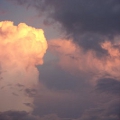
Cloud Whisperer

Posts: 1953 Joined: 05-Jan-2009 Last visit: 22-Jan-2020 Location: Amongst the clouds
|
endlessness wrote:I finally tried this yesterday, the sanango eyedrops from the Yawanawa people, during an ayahuasca ceremony. One drop to each eye... The moment it hits the eye, it takes about a second for it to start burning A LOT. It's a very intense piercing pain, my instinct was to contract muscles and hold my face with my hands, but my good friend who applied it passed his hand softly on my forehead and told me to try to relax.
The burning sensation lasted for maybe 5 minutes, but the first minute or two are the worse. Then the pain gives way to a lot of tears and clearing of synus, and a sensation of opened headspace and improved eyesight/deeper vision. This lasted for many hours, with a feeling of healing me too! Very special medicine! Endlessness This is incredibly fascinating and has definitely sparked my interest in Tabernaemontana sananho, may I ask what is the method of preparation that the Yawanawa people use to make the eye drops? Much Peace and Kindness
|
|
|

DMT-Nexus member
 
Posts: 12340 Joined: 12-Nov-2008 Last visit: 02-Apr-2023 Location: pacific
|
"I tried to change my name here to "Kambogahuascanga" due to this new found devotion to these sacred drops" Just ask Trav if you want to change your name. Long live the unwoke.
|
|
|
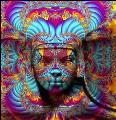
It's better to have things, and not be running out than it is to be running out and not be having things.
Posts: 95 Joined: 13-Jul-2014 Last visit: 30-Mar-2015 Location: Emerald City
|
3-Hydroxycoronaridine I hope the attatched file helps answer a few of the questions regarding needed info on 3-Hydroxycoronaridine. This is my 1st attempt to attatch a file. I hope it works and is useful. I am personally VERY interested in T. Iboga for reasons that shall become obvious in my posts in the near future. Metabolite Information Structural formula Name 3-Hydroxycoronaridine 19-Hydroxycoronaridine Formula C21H26N2O3 Mw 354.19434271 CAS RN 56867-69-7 C_ID C00025748 Organism Kingdom Family Species Reference Plantae Apocynaceae Pandaca mocquerysii Ref. Plantae Apocynaceae Tabernaemontana eglandulosa Stapf Ref. Plantae Apocynaceae Tabernaemontana sananho Ruiz et Pav. Ref. - - Gabunia eglandulosa Ref. zoom in HippingTrippY attached the following image(s):  Screen Shot 2014-07-21 at 2.39.31 PM.png (76kb) downloaded 434 time(s).
|
|
|
DMT-Nexus member
Posts: 54 Joined: 27-Jan-2013 Last visit: 25-Feb-2021
|
Has T. Undulata been analyzed by the community?
If not, I got three plants and might be able to produce some samples of leaf, stem and latex not too far into the future.
|
|
|
DMT-Nexus member
Posts: 5 Joined: 06-Dec-2014 Last visit: 03-Mar-2015 Location: Peru
|
This sounds like a fascinating plant, I saw it mentioned on the website of the Takiwasi ayahuasca rehab center in Tarapoto Peru. I have poor eyesight and under active tear production. Kambogahuasca, do you think uchu sanango permanently improved your vision? How similar is it to Iboga? I will try to find some to work with soon.
|
|
|
DMT-Nexus member
Posts: 5 Joined: 06-Dec-2014 Last visit: 03-Mar-2015 Location: Peru
|
I was also wondering if anybody knows how long this plant takes to be harvestable. The usually prohibitive price of T. Iboga outside of west Africa is because it takes around 5-7 years to produce ibogaine, and it was only recently introduced to the Americas. Perhaps Ushusanango would be easier to cultivate in South America since it is native and already established, especially if it matures sooner than iboga.
|
|
|

DMT-Nexus member

Posts: 459 Joined: 19-Jul-2012 Last visit: 04-Dec-2025
|
idk if this is the right place to post this but there is hardly any information on germinating this plant (T. Undulata) so I thought I would post some information here. I obtained my information from madplanter. Seeds came from WorldSeedSupplyI took some basic soil then put a hole in the center placed some spaghnum and placed the seed on top. 2-3 months later I had germination. These had a plastic covering for awhile, I noticed some fungus so I removed it, and allowed it to get water from the greenhouse irrigation. I believe I have 3 sprouts. I tried making a spaghnum blanket for the other 3, that did not seem to work as far as I could tell, I am also trying 4 in a plastic bag filled with spaghnum to see if that works as well, someone on sharetheseeds suggested that to me. Muskogee Herbman attached the following image(s):  DSC_0112.jpg (935kb) downloaded 298 time(s).Creator help me live in a way that will make my ancestors proud.
|